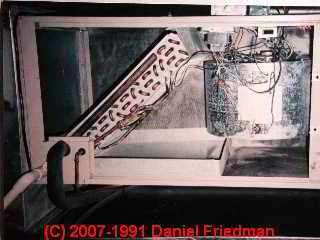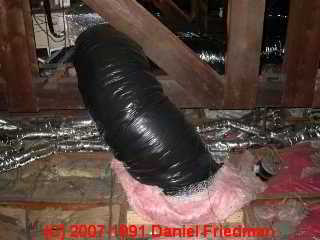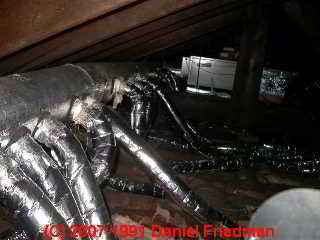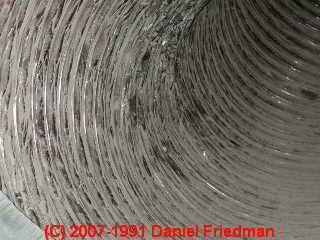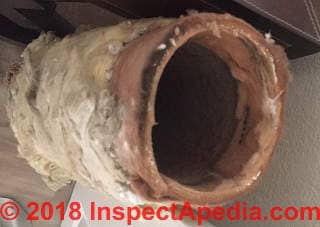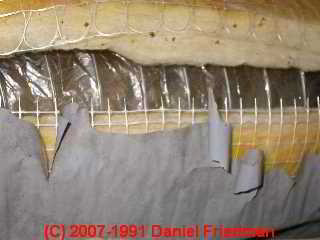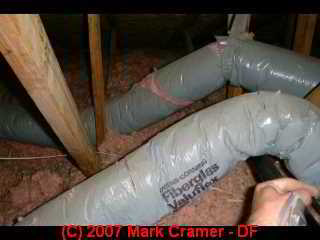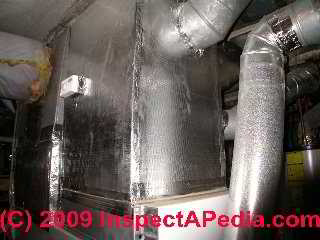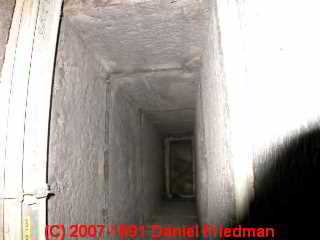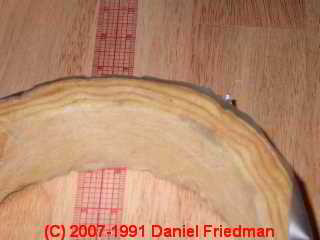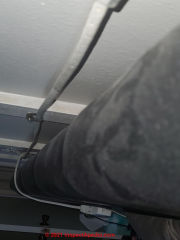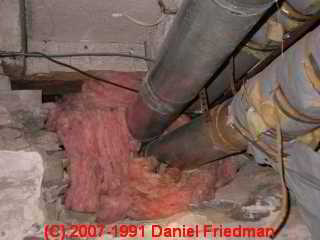 Fiberglass HVAC Duct
Fiberglass HVAC Duct
Types, Installation, Standards, Hazards
- POST a QUESTION or COMMENT about all types of fiberglass air ducrts used in heating & cooling systems, including installation standards, cleaning, leaks, contamination, & possible sources of small fiberglass fragments found in indoor air & dust samples
Fiberglass air ducts: types, problems, damage, sources of fiberglass dust & debris.
Here we describe the different types of fiberglass heating & cooling ducts including fiberglass duct wrap, flexible fiberglass insulated ductwork, fiberglass duct board, and fiberglass duct inspection, installation, cleaning, and restoration.
This document provides information about fiberglass hazards in heating and air conditioning ductwork in residential and light-commercial buildings. We also discuss HVAC duct damage as a source of airborne fiberglass fragments:
We discuss how Fiberglass from HVAC Ducts Can Appear in Indoor Air. Sources and detection of airborne fiberglass in buildings and possible air quality or health issues with fiberglass ducts and other HVAC components.
InspectAPedia tolerates no conflicts of interest. We have no relationship with advertisers, products, or services discussed at this website.
Types of Fiberglass HVAC Ducts
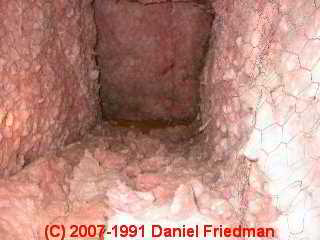 Fiberglass insulation material appears in several forms in heating and air conditioning systems in both ducts and air handlers themselves.
Fiberglass insulation material appears in several forms in heating and air conditioning systems in both ducts and air handlers themselves.
The most common uses of fiberglass insulating material in HVAC systems includes the cases listed below.
The annotated duct system photographs below show the most common types of fiberglass HVAC duct materials.
We provide these © protected photographs of fiberglass insulated ducts and HVAC components to aid in recognition of these materials.
Types of HVAC Ductwork Using Fiberglass
Fiberglass Insulating Mats In / At Air Handlers
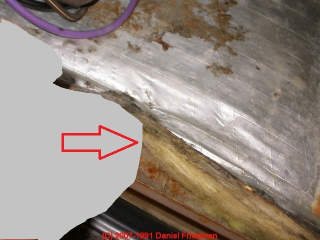
Fiberglass insulating mats inside of furnaces and boilers, usually enclosed within a steel jacket surrounding the system but possibly also present within the air handler of furnaces and central air conditioning blowers.
The insulation shown in these photos has been subject to condensate or external leaks, risking a mold contamination problem in the system.
In photo below fiberglass materials have been used inside the air handler sides and top in a foil-faced form (unlikely to release many fibers into the duct system) and a binder-coated mat on the air handler base.
Fiberglass Duct Wraps
Fiberglass insulating mats and duct linings are used inside air handlers and on the interior of metal HVAC ducts both inside buildings and in exterior roof-mounted duct systems.
Fiberglass insulating wrap
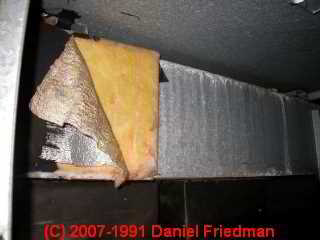
Fiberglass insulating wrap installed on the outside of metal duct work or air handling equipment is shown in the left photo above.
Building insulation is not designed for use inside of HVAC ducts and lacks the binding resin that is applied to minimize airborne fiberglass particle release into the building.
Watch out: The photo above shows home-made air handler and return plenum insulation liner using fiberglass batts, resulting in a higher risk of release of unusual levels of fiberglass into the indoor air of the building.
See details at FIBERGLASS FRAGMENT HAZARDS in AIR or DUST
More examples of damage to ductwork due to physical events or mechanical activity or cleaning are found
Foil-Covered or Mylar® Covered Fiberglass Flex Duct
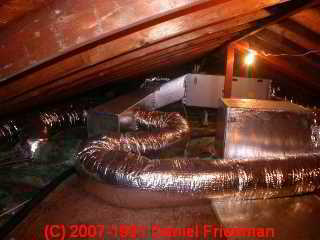
The flex duct shown above is a newly-installed foil-faced flex duct product.
The photograph just below shows foil-faced smaller-diameter high-velocity HVAC ducts as well as the main trunk line which has also been covered with foil-faced fiberglass insulation.
More about these small diameter air ducts is
Below we illustrate a clean, newly-installed foil-faced flex-duct section that uses foil or mylar on both the duct interior and exterior surfaces - significantly-reducing the concern for fiberglass damage and relerase.
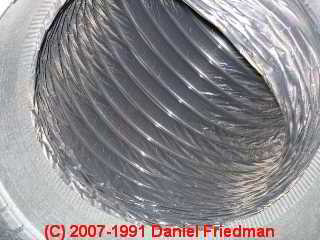
Below we show the typical debris we observe inside of most duct systems.
This debris could have been prevented inside the duct system by better filtration at return air inlets. In a home without mold or allergen or similar indoor air quality complaints, usually we find in the lab that this gray dusty debris is comprised principally of skin cells and fabric fibers.
See details at WHY DOES MOLD GROW in INSULATION?
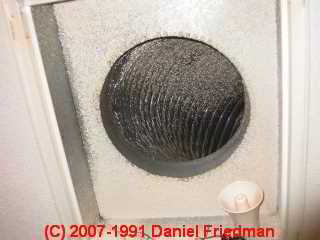
Above our shows white paint over sprayed into a ceiling supply duct - not to be mistaken for duct contamination, but an indicator of hasty workmanship.
Plastic-Covered Fiberglass Flex Duct
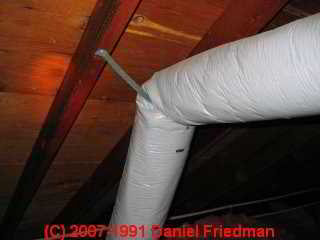
Flex duct with fiberglass insulation sandwiched between a plastic inner and outer wrap.
Flex duct may be used for both supply air (shown above), poorly installed and crimped) and return air (shown below ) in buildings.
Johns Manville Micro-Aire® FS Fiberglass Ductwork is illustrated just below.
Details about these older Johns Manville Micro-Aire® HVAC ducts as well as current Micro-Aire® duct specifications are at
Plastic-Wrapped Flex-Duct Failures
Below are examples of defective plastic-covered flex-duct products.
Goodman™ gray flex duct has failed in the photo above.
Owens Corning ValuFlex™ gray flex duct can also show this failure as shown in the photo below where, like the Goodman flex duct, the plastic exterior duct wrap has failed [second photo by Mark Cramer, ASHI Home Inspector, Tampa Florida].
See details at GRAY FLEXDUCT FAILURES - home
Fiberglass Duct Board: rigid rectangular fiberglass duct work
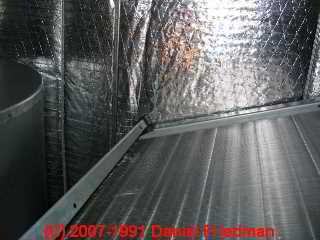
Rigid rectangular fiberglass duct work is visible as the return air plenum in the right of the first photo above. This material is usually used for HVAC trunk lines and a variant of it is often found inside of air handlers shown above as an interior view and below as an exterior view of a supply plenum made of foil faced rigid duct board.
Below we see both foil covered flexible fiberglass HVAC ducts and rigid foil-faced fiberglass ductboard forming supply and return air plenums at the air handler.
Below is fiberglass duct board shown on the interior of a rigid duct system.
See details of rigid fiberglass duct board insulation
at FIBERGLASS DUCT, RIGID CONSTRUCTION
Also see
- Owens Corning, OWENS CORNING FIBERGLAS® ENDURACOAT® DUCT SYSTEM [PDF] (1995) Submittal Sheet + supplemental data including clearance to combustibles, Louisiana Office of State Fire Marshal, 8181 Independence Blvd. Baton Rouge, Louisiana 70806
1-800-256-5452 http://lasfm.org/ retrieved 2019/02/07, includes additional information including clearance to combustibles and installation instructions
original source: http://sfm.dps.louisiana.gov/doc/gbmemos/Bad%20Memos/bm_28.pdf
Rigid Round Fiberglass HVAC ducts
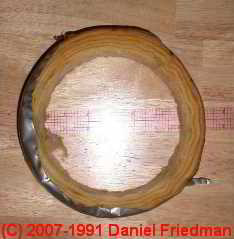
Rigid round fiberglass duct work is sometimes used for distribution of heated or cooled air through building walls or ceilings.
Notice that the fiberglass is fully exposed on the interior of this product, making it impossible to clean and providing a surface which easily traps debris.
Reader Comments, Questions & Answers About The Article Above
Below you will find questions and answers previously posted on this page at its page bottom reader comment box.
Reader Q&A - also see RECOMMENDED ARTICLES & FAQs
On 2022-03-19 by Inspectapedia Com Moderator (mod)
- STEPS in TRACKING DOWN FIBERGLASS DUST BLOWING OUT OF AIR REGISTERS
Re-posted here by (Mod) 2022/03/19
Anonymous asked (2022/03/18) - Who can diagnose fiberglass insulation dust blowing out of our HVAC ducts
I tried to post this after an article but your comments box is not loading (I am using Chrome browser on a PC).
Can you recommend what type of professional I might contact to try and help me with this issue (I've read the articles on your site): When the HVAC comes on a VERY fine layer of loose insulation dust causes me to sneeze and coats the surfaces.
It's visible, especially on shiny black plastic appliances; such as the TV. I went up into the attic and there didn't appear to be any noticeable loose or ripped plastic hose ducts. Unfortunately, the loose-fill insulation blown into the attic covers the connections around the base of most of the connections to the vents in the ceiling below.
Also, there are many connections down into the wall above the HVAC unit (small apartment unit) that I could not reach to see. The attic has crawl boards. In other words, the professional isn't going to have an easy job of checking this issue.
The apartment maintenance people "didn't see any problems," so they are no help. Am I likely to be able to find a professional to help me with this? I don't want to spend a fortune on it as I don't own the apartment, but it is a serious problem for me.
I don't want someone to just sell me a "package" for cleaning and inspecting vents. Any suggestions would be greatly appreciated. I really like your site! I look forward to making better use if it when I buy a property. - Anonymous by private email
Moderator reply: Mostcommon causes of fiberglass dust blowing out of ducts
Thank you so much for contacting us and for the question. Indeed the Comments Box code has been broken all day - it's a third party code provider and I'm in touch with them but they haven't fixed the trouble. Apologies.
I agree that it's preferable to diagnose the cause of unusual levels or types of indoor dust and to fix that rather than stacking on more layers of treatment or filtering.
Before spending "a fortune" or hiring someone who might out to be less than helpfully thorough, let's do some thinking and checking.
The two most-common causes of the trouble you describe as fiberglass dust blowing out of the HVAC ducts
1. someone tried to clean fiberglass lined HVAC ducts using a mechanical process that damaged the insulation - have you recently had such work done?
and
2. there is a return air inlet that's picking up insulation from a point nearby
or less likely a third:
3. Damage in the blower compartment of the air handler that has caused the insulation lining that area to become damaged.
Sometimes in our forensic lab I check dust samples for fiberglass: we can sometimes see by the resin color just which fiberglass product it is - distinguishing for example between attic insulation and duct lined insulation - but I'm out of the U.S. for now so can't offer that aid.
Reader follow-up: not all of ductwork is readily accessible for inspection
Thank you for your quick response. No one has cleaned the ducts. Based on one of your articles, I checked the fiberglass mat around the return just past the air filter. It is a little abraded, but more specifically, it is black and the dust is cream colored-more like the attic insulation.
There is no visible insulation near the return point, but the unit is tightly fitted in an unfinished space in the wall in the hall and I can't see how far back the space goes to see what is in it. I do know that there is a thick wall space behind it that includes the back of the fireplace- but cannot see any of that.
The unit would have to be pulled out to see behind it. Speaking of that space, it is above that thick wall space with the fireplace back that I can see the ducts in the attic all converging and connecting to a rectangular duct (junction?) and going down into that space. But I can't get near it in the attic (without risking stepping through the ceiling!)
Thanks for any other suggestions. I hope I'm not interrupting your vacation.
Moderator reply: hiring a duct inspection company using a duct camera system
Regrets but I don't have a clear picture of your building and its system nor of course of possible fiberglass dust sources. (No you're not interrupting a vacation. We're glad to help if we can.)
Your initial message strongly suggests that the HVAC system is either picking up or creating the dust that you're seeing.
Check these HVAC Duct & Air Handler Fiberglass Dust Sources
- Confirm that the dust is principally fiberglass
- Confirm that your HVAC ducts actually include fiberglass in their construction (flexduct) or lining (metal ductwork)
- Check for damaged insulation in the air handler blower compartment itself
- Inspect all accessible ducts for visible damage you can see from the duct interior, including crushing or even simply open connections- note (and tell us) if you can see a brand or labeling of the manufacturer of any flexible ducts in your home (there are some known-problem brands)
- Inspect the dust color for fiberglass clues- look for visible damage to duct insulation or blower compartment insulation
- Look for a return air inlet source of dust such as debris near a return air inlet
- You might then consider hiring a company who can inspect the entire duct interior using an inspection camera system.
Comments Box code has been repaired and up and running. As it will be helpful to other readers, and as its publication may prompt other readers to offer a helpful suggestion, I will include a redacted (to respect your privacy) version of this discussion in our article at
https://inspectapedia.com/Fiberglass/Fiberglass_Air_Ducts.php
near the bottom of that article.
If you viewed that page recently, to see the updated page you may need to clear your browser cache, and it may take up to 24 hours for the updated page to propagate through the internet to your server.
On 2021-12-31 by Inspectapedia Com Moderator (mod) - how to collect a duct dust sample
@Erin,
To identify what's in your dust you might use this
TEST KIT for DUST, MOLD, PARTICLES: INSTRUCTIONS https://inspectapedia.com/sickhouse/Adhesive_Tape_Particle_Test.php
and send the sample to any environmental test lab.
On 2021-12-31 by Erin
Help! Roof rats tore holes in all of our ductwork with insulation, RAT hair, etc coming thru vents into home. Son developed extreme hives and couch. * HAD ALL DUCTWORK REPLACED WITH NEW AND AN AERUS HVAC AIRSCRUBBER INSTALLED.
FIBERS that are long hair like, some kinky some straight-grayishblack, some black dots all thru house.
What do we do bow? How do I know what these fibers or dust actually are?
On 2020-09-19 - by (mod) -
I'm not sure which duct type you're asking about Ron: Flex duct or ductwork made from fibeglass panels, lined, unlined, with or without an aluminum foil surface, inside or on the exterior of duct systems.
But typically,
Non-Flexible duct board: "fibrous" insulating board is rated for temperatures between 0F (-18C) and 450F (232C)
Owens Corining flex duct rating is given by the company as
HVAC duct systems operating at internal air velocities not exceeding rated duct liner limitations as
listed below, and internal air temperatures between -20°F (-29°C) and 250°F (121°C) and air
velocities to 5,000 fpm (25.4 m/s).
- FLEX DUCT SPECIFICATIONS OWENS CORNING [PDF] https://inspectapedia.com/Fiberglass/Flexible-HVAC-Ducts-Guide-Spec-OwensCorning.pdf
On 2020-09-19 by ron smith
What is the temperature rating of fiber duct
On 2020-08-05 by (mod) - ID the fine fiber or something
I can't make out what's in your photo - except that there seems to be round air ducting with a black exterior insulation held on by bands.
You may want anon-site expert (see our page top EXPERTS DIRECTORY) to both identify the duct material and to inspect the duct interior, exterior, and building dust, and perhaps collect a sample or two so that you can both identify the dust that you think is the source of IAQ issues in your building and also to trace such dust to its source.
On 2020-08-05 by Alex L Carter - there is a really fine fiber or something
I've been living in this building for almost 6 months, i have not had a peaceful day since the first month, there is a really fine fiber or something that will develop over the course of a night and during the day sometime. I've noticed that I'm starting to lose my hear, whenever i comb it, I've started having a hard time breathing , it was so bad that i thought i had covid19 and was quarantine for 14days.
over said something to the manager but i was told i need to clean. it was very offences and rude needles to say he has not done anything.
i really need to find out what the heck this stuff is.. i wash my hair and ;like a ditty brown water comes out i can wash bit 2 times in the same day and it the same alexcartr74@live.com
On 2017-11-03 - by (mod) -
Irene
I can't assess the risk of a torn bit of fiberglass insulation from a brief e-text.
IF there is a lot of damaged, walked-on, or mechanically-damaged fiberglass insulation in an area where air movement picks up that dust and carries it into occupied space there could be a hazard of small fiberglass particles.
But certainly a bit of exposed fiberglass insulation in an attic is not likely to have a measurable effect in a building.
I cannot therefore cite an immediate danger to residents.
These longer articles may help you sort out the question you raise
FIBERGLASS HAZARDS - home. at inspectapedia.com/Fiberglass/Fiberglass_Hazards.php
FIBERGLASS FRAGMENT HAZARDS in AIR or DUST at inspectapedia.com/Fiberglass/Fiberglass_in_Air.php
And if a more thorough technical investigation were warranted see
FIBERGLASS DETECTION in BUILDING AIR & DUST - at inspectapedia.com/Fiberglass/Fiberglass_Detection_in_Air.php where we discuss again the distinction between large and small fiberglass particles
On 2017-11-03 by Irene grossi.
followup on last request. she his being treated by an allergist.
On 2017-11-03 by Irene grossi
A torn fiberglass insulation in attic has been open to the air one resident has a cough for over 8 months being treated by a dermatologist. please spell out immediate dangers to residents. asap. please.
On 2017-04-03 - by (mod) -
Berenice
Fiberglass insulation is sold in various colors, usually specific to a manufacturer. It doesn't have to be yellow.
But you should not be seeing insulation blowing into your occupied space from the HVAC system. If that's happening fiberglass somewhere in the air path is improperly-installed, damaged, or otherwise defective.
On 2017-04-03 by Berenice
The insulation that is coming in through HVAC system in new mobile home is a darker, almost purple color. Should it be yellow, like the insulation under trailer? Or does it get dirty and turn color?
...
Continue reading at FIBERGLASS DUCT, RIGID CONSTRUCTION or select a topic from the closely-related articles below, or see the complete ARTICLE INDEX.
Or see FIBERGLASS HVAC DUCT FAQs - questions & answers about fiberglass insulated ductwork that were posted originally on this page.
Or see these
Recommended Articles
- AIR HANDLER FIBERGLASS INSULATION
- DISINFECTANTS, SANITIZERS, FUNGICIDAL-SEALANTS SOURCES - sanitize or seal air duct interiors
- DUCT CLEANING ADVICE
- DUCT DAMAGE, MECHANICAL
- FIBERGLASS DETECTION in BUILDING AIR & DUST
- FIBERGLASS HAZARDS - home
- FIBERGLASS HVAC DUCTS - home
Suggested citation for this web page
FIBERGLASS HVAC DUCTS at InspectApedia.com - online encyclopedia of building & environmental inspection, testing, diagnosis, repair, & problem prevention advice.
Or see this
INDEX to RELATED ARTICLES: ARTICLE INDEX to FIBERGLASS HAZARDS
Or use the SEARCH BOX found below to Ask a Question or Search InspectApedia
Ask a Question or Search InspectApedia
Try the search box just below, or if you prefer, post a question or comment in the Comments box below and we will respond promptly.
Search the InspectApedia website
Note: appearance of your Comment below may be delayed: if your comment contains an image, photograph, web link, or text that looks to the software as if it might be a web link, your posting will appear after it has been approved by a moderator. Apologies for the delay.
Only one image can be added per comment but you can post as many comments, and therefore images, as you like.
You will not receive a notification when a response to your question has been posted.
Please bookmark this page to make it easy for you to check back for our response.
Our Comment Box is provided by Countable Web Productions countable.ca
Citations & References
In addition to any citations in the article above, a full list is available on request.
- ENVIRONMENTAL HEALTH & INVESTIGATION BIBLIOGRAPHY - our technical library on indoor air quality inspection, testing, laboratory procedures, forensic microscopy, etc.
- Adkins and Adkins Dictionary of Roman Religion discusses Robigus, the Roman god of crop protection and the legendary progenitor of wheat rust fungus.
- Kansas State University, department of plant pathology, extension plant pathology web page on wheat rust fungus: see http://www.oznet.ksu.edu/path-ext/factSheets/Wheat/Wheat%20Leaf%20Rust.asp
- A BRIEF GUIDE to MOLD, MOISTURE, and YOUR HOME, [PDF] U.S. Environmental Protection Agency US EPA - includes basic advice for building owners, occupants, and mold cleanup operations. See http://www.epa.gov/mold/moldguide.htm
- US EPA - Mold Remediation in Schools and Commercial Building [ copy on file as /sickhouse/EPA_Mold_Remediation_in_Schools.pdf ] - US EPA
- US EPA - UNA BREVA GUIA a MOHO / HONGO - en Espanol
https://publications.iarc.fr/ENG/Monographs/vol81/mono81-6A.pdf - article details
https://publications.iarc.fr/ENG/Monographs/vol81/mono81-6C.pdf - studies of cancer in experimental animals in re vitreous fibers such as fiberglass;
https://publications.iarc.fr/ENG/Monographs/vol81/mono81-6E.pdf - summary of data reported & evaluation
https://publications.iarc.fr/ENG/Monographs/vol81/mono81-6F.pdf for the article references
To search the IARC monographs on various environmental concerns and carcinogens, use https://publications.iarc.fr/ENG/Monographs/PDFs/index.php
CONTINUE READING or RECOMMENDED ARTICLES.
- Carson, Dunlop & Associates Ltd., 120 Carlton Street Suite 407, Toronto ON M5A 4K2. Tel: (416) 964-9415 1-800-268-7070 Email: info@carsondunlop.com. Alan Carson is a past president of ASHI, the American Society of Home Inspectors.
Thanks to Alan Carson and Bob Dunlop, for permission for InspectAPedia to use text excerpts from The HOME REFERENCE BOOK - the Encyclopedia of Homes and to use illustrations from The ILLUSTRATED HOME .
Carson Dunlop Associates provides extensive home inspection education and report writing material. In gratitude we provide links to tsome Carson Dunlop Associates products and services.


